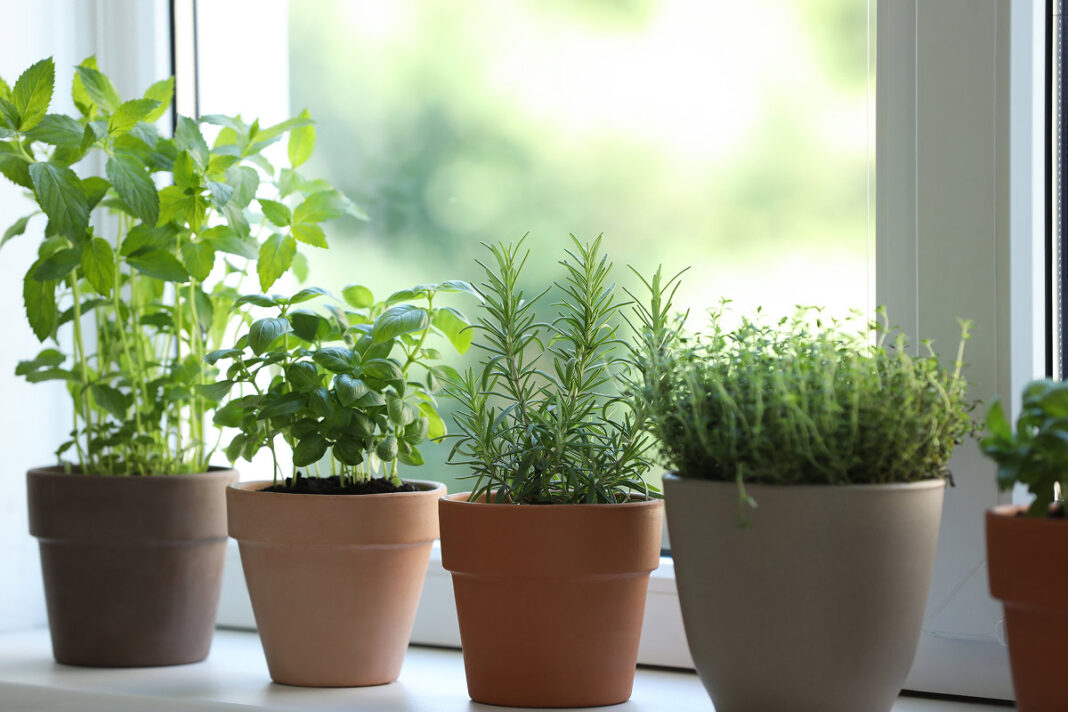An indoor herb garden can enliven the house with greenery and fresh aroma. The herbs can also be used to add flavor to home-cooked food. When setting up such a garden at home, one can choose from a variety of herbs, such as chives, mint, and parsley. Most of these plants do not require one to spend a lot of time on maintenance and can be easily grown by following a few simple steps.
Pick the Right Spot
The first step is to pick the right spot for the indoor herb garden setup. One must consider three factors when doing this.
Sunlight
Most herbs require six to eight hours of direct sunlight to thrive. Considering this, a window facing south or southwest would be a good spot for an indoor herb garden. It is also recommended that the pots be rotated every few days so that every leaf gets its share of direct sunlight.
Drainage
The roots of the herbs should not be moist for too long, as this can cause them to rot. So, when setting up an indoor herb garden, it is important to select a place that allows proper drainage. Countertops or window sills would work as long as there is enough space to place pots with trays or drainage pans under them.
Temperature
Herbs grow best in stable temperatures ranging between 65°F and 75°F. So when the cold season arrives, it is important to keep them away from windows. This way, their leaves will not touch the glass and get damaged due to a cold shock.
Choose and Prepare the Containers
Most herbs do not have deep root systems, so it’s okay to choose containers that are only about six inches deep. But since the herbs can—and probably would—be used for consumption, it is important to choose food-grade containers. Food-grade galvanized steel containers are a good choice. Containers made of natural materials like terra cotta clay and cedar will also work. These materials are porous, which allows them to release excess moisture, hence benefiting the herb roots. Those planning to grow herbs in small spaces can also consider hanging containers.
After choosing the containers, one would need to prepare them for growing herbs by drilling drainage holes. If this seems like a lot of work, one can buy plant containers that already have holes. For better drainage, one can consider laying a thin layer of pebbles or gravel at the bottom of the container.
Select the Herbs
After the space has been set up and the containers are ready, it’s time to choose the right herbs for the garden. Tender herbs with shallow root systems usually work well for the home. Keeping that in mind, chives, lemon balm, mint, and parsley are great herbs to grow indoors. Those looking for low-maintenance indoor herbs can especially consider basil, chives, parsley, thyme, and rosemary.
A great thing about herbs is that they do not tend to grow horizontally. Most of their growth is vertical. So, one can plant two different types of herbs in the same container. Choosing herbs with similar sunlight and watering requirements will make things easier. Planting parsley and basil together, for instance, can be a good option. Parsley can also be planted alongside lemon balm, rosemary, and thyme.
While there are quite a few herb options for indoor gardens, one must choose a variety they like to consume. This way, the herb garden will not only add greenery and freshness to the living space but also make one’s meals more flavorful.
Get the Right Soil
Most herbs do not thrive in soils that are soggy and retain moisture for long periods. Instead, they flourish in loose soils that drain quickly. For herbs such as rosemary, thyme, and oregano, using a mix of regular and cactus mix soil is therefore recommended. For a few other herbs, such as basil and mint, regular potting soil can work fine as long as the pots have proper drainage holes.
Follow the Right Watering Schedule
Watering the herbs correctly is a simple yet essential herb-growing tip for beginners. Indoor herbs need careful attention to avoid overwatering or underwatering. A good rule of thumb is to water the herb when the top inch of the soil feels dry to the touch. If the leaves droop or get shriveled, it could be a sign of the plant being under-watered.
Set Up an Artificial Light Source
The amount of natural light entering the windows will significantly reduce in winter. The herbs, however, will still need enough light to thrive, so one can invest in LED grow lights during the colder months. Placing herbs near these bulbs will ensure they continue to receive the light they need for photosynthesis and growth. This is an effective way of growing herbs with less sunlight.


